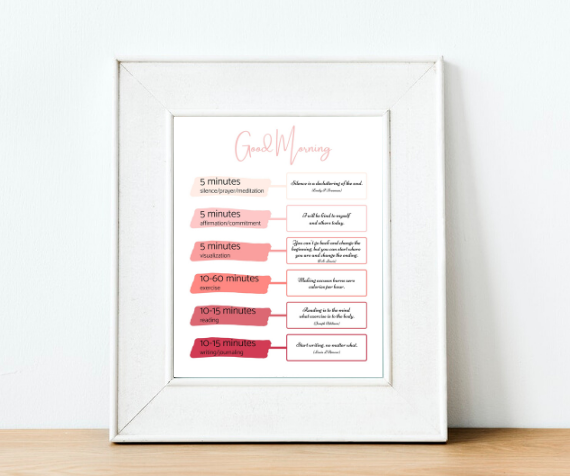The Three Habits that Will Change Your Life
Every single one of us has 24 hours. Every day. You probably want more. Remember those, “If You Give a Mouse a Cookie…” books? Someday I want to write, “If You Give a Mom 24 Hours…Chances Are, She’ll Want Another.” But I’ve found three daily habits that are critical for me to make efficient use of my time.
Creating routines, systems, and efficiencies is the way to accomplish more of what you want in any period of time. Tips and tricks for time management abound, but there are three daily habits that give you the most bang for your buck. By implementing these three practices, you will prioritize your time to get more done of what you want done.


DAILY HABIT #1: Have a Morning Routine
Nothing will set you up for better organizational success than a morning routine that works for you. Here’s how to create a morning routine to help you face the day ready for whatever comes next.
6 STEPS TO CREATE YOUR MORNING ROUTINE
Step 1. Dream up your perfect morning
List out all the things you’d put into your ideal morning routine
- make your bed
- exercise
- read
- check social media accounts
- make a healthy breakfast
- journal
- read news articles
Step 2. Write down all the things you currently do in the morning
Include all those things that eat up time without necessarily being on a to-do list.
- shower
- makeup
- make coffee
- load the dishwasher
- feed the dog
Step 3. Assign time estimates
Think through how much time these things realistically take. Work backward from your out-the-door time to determine what time you need to get up in order to do everything you’d like to do in the morning. DON’T STOP READING AND DON’T SET YOUR ALARM YET!
Step 4. Plan for success
Are there things you could be doing the night before to make mornings easier?
Could you shower, make lunches, set out breakfast dishes, or pre-load the Keurig? All those little things add up. Sometimes things that only take a few minutes can be overwhelming in the morning, especially if you have no routine.
Step 5. Realistically assess
You’ve probably created a packed morning routine. Maybe you think mornings will never work for you, or you plan to move your alarm for tomorrow up at least two hours. Don’t do that.
First, remove any items you decide to do in the evenings.
Then, keep the must-do’s in your routine, add in ONE thing that you really want to make time for, and set your alarm for 15 minutes earlier than usual.
Once you’ve spent a few weeks adapting to your new routine, you can add another thing or adjust as needed.
Step 6. Think about efficiencies
Now think about how to string those things together in a way that you will repeat EVERY morning. This is a routine. The more routine your routine, the less chaotic mornings will feel. If you need coffee before any other thing, put it first and stick to it. If you like to shower and dress and then sip your coffee—do that consistently. Put everything you do in order and as much as possible, repeat them in that order each day.

DON’T PRIORITIZE PERFECTION
Repetition is key to habit formation
It is work to establish routines like this, but once they become daily habits, they are tools that enable you to think less about the details. Following your routine perfectly every day is not the end goal. The goal is to reduce the mental chaos that comes from not having a plan.
Adjust if needed
There will be mornings you need to skip part of your routine. Having a routine allows you to make adjustments without panicking, because you’re familiar with the normal rhythm of your morning and can adjust.
If you find that you need to substantially adjust several mornings a week, you probably need to rethink your routine!
Start small and add more when you’re comfortable
There’s no value in trying to cram an unrealistic amount of stuff into your morning. Start by creating a simple routine with just the necessities and add one thing when you reach a level of comfort with that routine.
These articles can help you create your ideal morning routine
DAILY HABIT #2: Use Lists
Every person you think of as “organized” is utilizing lists in one form or another. The very act of writing something down solidifies and cements it into memory. One problem most people have with to-do lists is that they add too many things. To avoid this problem, let’s start with a master list.
MASTER LIST
A “brain dump” or master list is the best way to get everything out of your head and written down for future reference. There is no expectation of accomplishing all of those tasks tomorrow, next week, or even next month.
Get a notebook of some kind and jot down every single thing you can think of that you need or want to do. I mean EVERYTHING.
Depending on your circumstances, it may be helpful to create more than one master list. You may want to have one for personal use and one for business.
A master list can include any of the following:
- repeated tasks: vacuum, grocery shop, buy class snack
- occasional tasks: paint porch railing, schedule dental appointments
- tasks you would like to add to your life: take mom to afternoon tea, learn to knit
NEXT STEPS: I’VE GOT A MASTER LIST…NOW WHAT?
Schedule everything you can
Go through your master list and transfer anything that can be scheduled into a time slot on your calendar.
For a monthly task, look at your calendar for the night of the week that looks most free and schedule it in once a month for the rest of the year. If you later have a time conflict, you can move it to a different day, but you won’t forget about it.
EXAMPLE: If you’re responsible for sending in class snacks on the first of each month, schedule “buy class snack” in your calendar for the week before.
Add time estimates
If possible, put a time estimate next to the tasks on your master list. Try timing some of your regular household cleaning chores and I bet you’ll find that it takes less time than you think.
Keep updating your master list
Any time you think of something that you want to add to your to-do list or your “I wish I had time to do” list, write it down. To keep track of what is outstanding on your master list, use Sharpie to cross off completed items.
DAILY AND WEEKLY TO-DO LISTS
Choose a time to plan your list
Pick a specific day and time to look at your calendar and think about the week ahead. Many people do this on Sunday, but Friday can be a great option for planning also.
Create a to-do list for each day. Start with tasks that must happen on a specific day. Then look for gaps where you can schedule tasks that aren’t day specific, but need to happen sometime during that week. This includes any shopping, errands, cleaning, work projects, and so on.
The more routine you make your schedule, the better. If there is a certain day of the week that works best for you to do a big grocery run, schedule it repeatedly for that day.
Consult your master list
Consult your master list to see if there is anything you can fit into your week. This is why it helps to have time estimates for tasks included on your master list.
Scan your calendar
Scan ahead on your calendar to make your to-do list most efficient. If you plan to make cupcakes for your daughter’s birthday party, don’t just put “birthday party” on your calendar—break it down. Schedule time to make the cupcakes, shop for ingredients, and even time to browse Pinterest for fabulous cupcake decorating ideas.
PROBLEM: I MAKE A TO-DO LIST, BUT I NEVER GET IT DONE!
Don’t overschedule
Normal life activities eat up a lot of time. You may not be putting “unload the dishwasher” on your daily to-do list, but it probably takes ten minutes start to finish. Be realistic about how much time is taken up by driving from one place to another, helping kids with homework, or cooking dinner.
Be honest about wasted time
Finally, picture a daily calendar or agenda for last week with big black Sharpie blocking out all the time you spent playing games on your phone, scrolling through social media, or vegging out in front of Netflix. Make sure you are aware of the amount of time you are choosing to spend on those activities.


DAILY HABIT #3: Create an Evening Routine
Evening routines ease your morning rush, keep you motivated and on track, and help you discover ways to refine all your other organizational routines. This is probably the least-used of the three daily habits. But without an evening routine, mornings may spiral into chaos when something unexpected happens. I categorize evening routines in three ways:
EVENING ROUTINE: DOING
The active part of an evening routine consists of things that you actively do to prepare for the next day. You may find that it helps to plan outfits for you or your kids the night before, pull something out of the freezer to thaw for tomorrow’s dinner, or place everything that needs to leave the house with you in one specific spot near the door. Plan these routines the same way as morning routines.
Think through what you could do in the evening to make tomorrow easier, and decide which of those things you want to regularly make a part of your evenings.
Decide at what point in the evening you will do them. Before dinner? After dinner? After kids go to bed?
Then, make yourself an evening routine checklist. Consistency is key, but adjust if your initial routine isn’t working. It may take some time to find out what works best for you.
EVENING ROUTINE: PLANNING
A second type of evening routine is not actively DOING, but intentionally PLANNING for tomorrow.
Set aside a brief time to look over your calendar and agenda for the upcoming days. You can adjust your schedule if necessary, and fill in something from your master list if it looks like you have time for that.
Think through your agenda and look for ways you can be more efficient with your time.
Visualizing step-by-step through your activities for the next day can reveal where you may need to tweak your schedule a bit.
This planning step may expose inefficiencies or little bits of overlooked time. For example, if you see that on Tuesday you will have 30 minutes waiting for your daughter at the orthodontist, you can plan to bring something to utilize that time productively. In 30 minutes, you could write a few thank you notes of encouragement to somebody. If you started the year wanting to take up a new hobby, use that time to watch a YouTube tutorial. Prep a craft project for an upcoming holiday or birthday. Scrolling through Pinterest can be productive too if you have a plan!
The planning part of your evening routine doesn’t have to take long, but this habit will enable you to make productive use of those extra little bits of time.
EVENING ROUTINE: THINKING
The third type of evening routine can be hard to prioritize, but it has immense value. This is a time of journaling, dreaming, and thinking about what is working or not working in your life. It’s not tied to any schedule or agenda. You may find it especially helpful to include this at beginning of a year or season, or when you are in a period of change.
This is a time to think through which things in your life are urgent vs. those that are important, as famously said by Dwight D. Eisenhower.
“I have two kinds of problems, the urgent and the important. The urgent are not important, and the important are never urgent.” https://www.eisenhower.me/eisenhower-matrix/
MAKE YOUR TIME COUNT
These three powerful daily habits: morning routines, lists, and evening routines, work together to create a flow of thoughtful productivity.
Look over your daily to-do list as part of your morning routine, so that your priorities for the day are at the forefront of your mind.
As part of your evening routine, review your plans for the next few days and adjust your daily to-do lists if needed.
You will never have the time that you think will come with next month, next year, or the next stage of life.
Without conscious and purposeful thought about how you are spending your time, the natural inclination is to let life overwhelm us with the urgent. When you think you are too busy to do something that you wish to do, think about what you are making time for instead.

Prioritize in practice the things that are important to you in principle. We only have time for the things we make time for. Use the three daily habits of morning routines, daily lists, and evening routines to make your time count.











